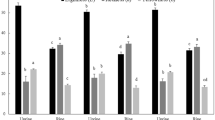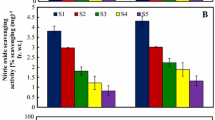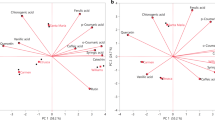Abstract
The rationale of this study is to compare the levels of different antioxidants present in commercially important tomato cultivars of India, specifically developed to grow in high altitude and plain regions. Major antioxidant components like lycopene, ascorbic acid, phenolics, and quenching capacity of free radicals were analysed in different fractions of tomato fruit, i.e., skin, pulp, and seed fractions. Significant differences in antioxidant components were observed among the fractions of the different cultivars studied. Lycopene content was found to be more in high altitude cultivars (‘Sindhu’ and ‘Shalimar’); however, ascorbic acid and phenolic content were found to be higher in plain region cultivars (‘PKM1’ and ‘CO3’). To evaluate the antioxidant capacity, 2,2-diphenyl-1-picrylhydrazyl (DPPH) and ferric reducing/antioxidant power (FRAP) assays were performed. High altitude cultivars showed 10–15% higher DPPH free radical scavenging activity and 20–30% increase in FRAP than the plain region cultivars. Among the different fruit fractions analysed, skin showed the highest level of antioxidants levels and free radical scavenging activities in all the cultivars tested. The difference in the antioxidants level and activity may be attributed to the genetic variability of the cultivars.
Similar content being viewed by others
References
Agarwal S, Rao AV. Tomato lycopene and its role in human health and chronic diseases. Can. Med. Assoc. J. 163: 739–744 (2000)
Leonardi C, Ambrosino P, Esposito F, Fogliano V. Antioxidant activity and carotenoid and tomatine contents in different typologies of fresh consumption tomatoes. J. Agr. Food Chem. 48: 4723–4727 (2000)
Stewart AJ, Bozonnet S, Mullen W, Jenkins GI, Lean MEJ, Crozier A. Occurrence of avonols in tomatoes and tomato-based products. J. Agr. Food Chem. 48: 2663–2669 (2000)
Beutner S, Bloedorn B, Frixel S, Blanco IH, Hoffmann T, Martin H, Mayer B, Noack P, Ruck C, Schmidt M, Schulke I, Sell S, Ernst H, Haremza S, Seybold GN, Sies H, Stahl W, Walsh R. Quantitative assessment of antioxidant properties of natural colorants and phytochemicals: Carotenoids, avonoids, phenols, and indigoids. The role of β-carotene in antioxidant functions. J. Sci. Food Agr. 81: 559–568 (2001)
Adegoroye AS, Jolliffe PA. Some inhibitory effects of radiation stress on tomato fruit ripening. J. Sci. Food Agr. 39: 297–302 (1987)
Dumas Y, Dadomo M, DiLucca G, Grolier P. Effects of environmental factors and agricultural techniques on antioxidant content of tomatoes. J. Sci. Food Agr. 83: 369–382 (2003)
Leoni C. Industrial quality as inuenced by crop management. Acta Hortic. 301: 177–184 (1992)
Robertson GH, Mahoney NE, Goodman N, Pavlath AE. Regulation of lycopene formation in cell suspension culture of VFNT tomato (Lycopersicon esculentum) by CPTA, growth regulators, sucrose, and temperature. J. Exp. Bot. 46: 667–673 (1995)
Hamauzu Y, Chachin K, Ueda Y. Effect of post harvest temperature on the conversion of 14C-mevalonic acid to carotenes in tomato fruits. J. Jpn. Soc. Hort. Sci. 67: 549–555 (1998)
Lee SK, Kader AA. Preharvest and postharvest factors inuencing vitamin C content of horticultural crops. Postharvest Biol. Tec. 20: 207–220 (2000)
Howard LR, Pandjaitan N, Morelock T, Gil MI. Antioxidant capacity and phenolic content of spinach as affected by genetics and growing season. J. Agr. Food Chem. 50: 5891–5896 (2002)
Rao VS, Waseem Z, Agarwal S. Lycopene content of tomatoes and tomato products and their contribution to dietary lycopene. Food Res. Int. 31: 737–741 (1998)
Klein BP, Perr AK. Ascorbic acid and vitamin A activity in selected vegetables from different geographical areas of the United Sstates. J. Food Sci. 47: 941–945 (1982)
Spanos GA, Wrolstad RE. Influence of processing and storage of the phenolic composition of Thompson seedless grape juice. J. Agr. Food Chem. 38: 1565–1571 (1990)
Gyamfi MA, Yonamine M, Aniya Y. Free radical scavenging action of medicinal herbs from Ghana Thonningia sanguinea on experimentally-induced liver injuries. Gen. Pharmacol. 32: 661–667 (1999)
Benzie IEF, Strain JJ. The ferric reducing ability of plasma (FRAP) as a measure of antioxidant power: The FRAP assay. Anal. Biochem. 239: 70–76 (1996)
George B, Kaur C, Khurdiya DS, Kapoor HC. Antioxidants in tomato (Lycopersium esculentum) as a function of genotype. Food Chem. 84: 45–51 (2004)
Stahl W, Sies H. Lycopene: A biologically important carotenoid for humans? Arch. Biochem Biophys. 336: 1–9 (1996)
Shi J, Le Maguer M. Lycopene in tomatoes. Chemical and physical properties affected by food processing. Crit. Rev. Food Sci. 110: 1–42 (2000)
Sharma SK, Le Maguer M. Lycopene in tomatoes and tomato pulp fractions. Ital. J. Food Sci. 8: 107–113 (1996)
Toor RK, Savage GP. Antioxidant activity in different fractions of tomato cultivars. Food Res. Int. 35: 487–494 (2005)
Javanmardi J, Kubota C. Variation of lycopene, antioxidant activity, total soluble solids, and weight loss of tomato during postharvest storage. Postharvest Biol. Tec. 41: 151–155 (2006)
Al-Wandawi H, Abdul-Rahman M, Al-Shaikhly K. Tomato processing wastes as essential raw materials source. J. Agr. Food Chem. 33: 804–807 (1985)
Abushita AA, Daood HG, Biacs PA. Changes in carotenoids and antioxidant vitamins in tomato as a function of varietal and technological factors. J. Agr. Food Chem. 48: 2075–2081 (2000)
Rao VS, Yadav DS. Preliminary evaluation of some varieties for processing under Imphal valley conditions. Agr. Sci. Digest 8: 149–152 (1988)
Thakur NS, LalKaushal BB. Study of Quality Characteristics of Some Commercial Varieties and F1 Hybrids of Tomato Grown in Himachal Pradesh in Relation to Processing. Indian Food Packer. NISCAIR, Delhi, India. pp. 25–31 (1995)
Chang YH, Raymundo LC, Glass RW, Simpson KL. Effect of high temperature on CPTA-induced carotenoid biosynthesis in ripening tomato fruits. J. Agr. Food Chem. 25: 1249–1251 (1977)
Davey MW, VanMontagu M, Inze D, Sanmartin M, Kanellis A, Smirnoff N, Benzie IJJ, Strain JJ, Favell D, Fletcher J. Plant l-ascorbic acid: Chemistry, function, metabolism, bioavailability, and effects of processing. J. Agr. Food Chem. 80: 825–860 (2000)
Negro C, Tommasi L, Miceli A. Phenolic compounds and antioxidant activity from red grape marc extracts. Bioresource Technol. 87: 41–44 (2003)
Vinson JA, Hao Y, Su X, Zubik L, Hao Y, Su XH. Phenol antioxidant quantity and quality in foods: Vegetables. J. Agr. Food Chem. 46: 3630–3634 (1998)
Prasad ND, Sudhakar N, Murugesan K, Mohan N. Pre-exposure of calli to ozone promotes tolerance of regenerated Lycopersicon esculentum cv. PKM1 plantlets against acute ozone stress. J. Plant Physiol. 165: 1288–1299 (2008)
Hunt GM, Baker EA. Phenolic constituents of tomato fruit cuticles. Phytochemistry 19: 1415–1419 (1980)
Toor RK, Savage GP, Lister CE. Seasonal variations in the antioxidant composition of greenhouse grown tomatoes. J. Food Compos. Anal. 19: 1–10 (2006)
Smith H. Regulatory Mechanisms in the Photocontrol of Flavonoid Biosynthesis. Academic Press, New York, NY, USA. pp. 303–320 (1973)
Guo C, Yang J, Wei J, Li Y, Xu J, Jiang Y. Antioxidant activities of peel, pulp, and seed fractions of common fruits as determined by FRAP assay. Nutr Res. 23: 1719–1726 (2003)
Zhang DZ, Fang YZ. Observation on antioxidative activity of some vegetables and fruits. Acta Nutr. Sin. 12: 191–195 (1990)
Sun J, Chu YF, Wu XZ, Liu RH. Antioxidant and antiproliferative activities of common fruits. J. Agr. Food Chem. 50: 7449–7454 (2002)
Halvorsen BL, Holte K, Myhrstad MCW, Barikmo I, Hvattum E, Remberg SF, Wold AB, Haffner K, Baugerod H, Anderson LF, Moskaug J, Jacobs DR, Blomhoff R. A systematic screening of total antioxidants in dietary plants. J Nutr. 132: 461–471 (2002)
Author information
Authors and Affiliations
Corresponding author
Rights and permissions
About this article
Cite this article
Chandra, H.M., Ramalingam, S. Antioxidant potentials of skin, pulp, and seed fractions of commercially important tomato cultivars. Food Sci Biotechnol 20, 15–21 (2011). https://doi.org/10.1007/s10068-011-0003-z
Received:
Revised:
Accepted:
Published:
Issue Date:
DOI: https://doi.org/10.1007/s10068-011-0003-z




